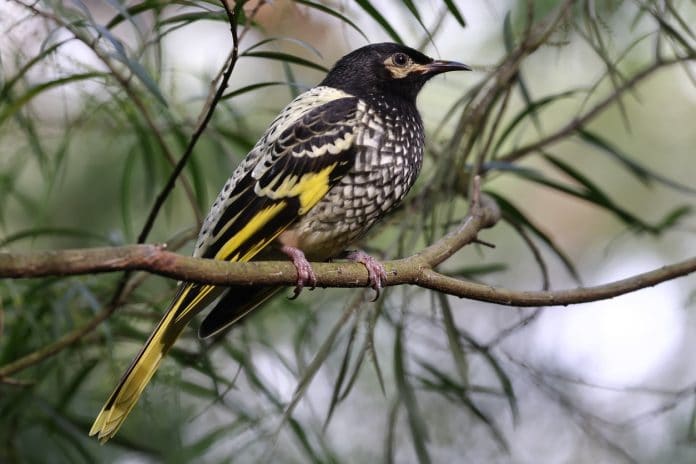Hunter Valley conservationists are battling to save the critically-endangered Regent Honeyeater by embarking on a mistletoe planting blitz – a vital food and nesting source for the threatened species – after most was destroyed by the intense 2019/20 bushfires.
Experts from BirdLife Australia will partner with the traditional custodians, Mindaribba Local Aboriginal Land Council (LALC), to facilitate a two-way knowledge-sharing workshop with local landholders, government agency staff and environmental volunteers.
The workshop will bring together their collective knowledge of country, ecology, bush regeneration and land management, passing on the skills of identifying mistletoe, and how to collect the fruit, store and then plant the seeds into suitable host trees.
The Regent Honeyeater is endangered, owing to many reasons including historical and ongoing habitat destruction and fragmentation, with their small population size now recognised as a key threat, leading to a loss of its “song culture”.
Populations have reached such low numbers that it seems that young males are not getting the chance to learn mating calls from other adults, leading to a drop in reproduction rates.
Natural processes for mistletoe to return to these forests (mostly via spread by birds such as the Mistletoebird) would take a long time to occur – too long for the critically endangered Regent Honeyeater.
On these lands, the project team will expedite the process by planting the mistletoe seeds themselves.
In theory, this mistletoe could function as habitat within three or four years, so the benefit is far sooner than planting trees.
Key to this successful program, which secured $50,000 funding from Landcare Led Bushfire Recovery Grants, is training volunteers to source fruit from mistletoe clumps and prepare for arborists to plant them into the burnt areas.
“Volunteers will help us plant the seeds low down as we walk around the forest, which will eventually attract Mistletoebirds back to the area,” BirdLife Australia NSW woodland birds project officer Kristy Peters said.
“But, that wouldn’t help our Regent Honeyeaters as they only use mistletoe clumps that are high in the trees.
“So, to get the seeds up into the canopy we employ professional arborists to hoist the seeds up high to places where the birds will use them.
“Native mistletoe is really abundant but when it fruits, it doesn’t have a long shelf life and needs to be planted soon afterwards.
“That’s why we need to educate landholders and volunteers in mistletoe missions, so they can learn how to carefully pick the fruit, store overnight in suitable conditions if need be and plant the seeds quickly.
“We want them to learn how to handle the fruit so they can do it themselves, wipe the seeds on the underside of a branch and learn the tricks involved.”
Working closely with Mindaribba LALC and local Landcare groups, BirdLife Australia aims to restore a key breeding resource for Regent Honeyeaters by regenerating the mistletoe population.
Their target is to plant at least 1000 Long-flowered Mistletoe seeds into host trees by the project’s completion.
“The project site, Tomalpin Woodlands, near Kurri Kurri, is one of the most important contemporary breeding areas for Regent Honeyeaters,” Ms Peters said.
“However, since 2015, consistent fire damage has impacted the site and after the Black Summer fires having burnt other contemporary breeding sites, including Capertee, Widden and Burragorang Valleys, there is a very urgent need to restore breeding habitat such as the mistletoe in the Tomalpin Woodlands.”
A nomadic species, Ms Peters explained the bittersweet detail in the Regent Honeyeater’s loss of song, owing to their population decline.
“Lone males often can’t find females to breed, they can’t find enough of their own kind out in the wild,” she said.
“Young males don’t learn the songs from their fathers, because the adult males don’t sing while they rear their offspring.
“When the young leave the nest, they would usually come across other Regent Honeyeaters and learn songs from other adult males.
“But, with far fewer birds around to learn from, they are mimicking the calls of other species that they are co-existing with, like Red Wattlebirds and Noisy Friarbirds.
“The female birds don’t respond well to these calls which leads to lower nest success.”
The project aims to restore the Tomalpin Woodlands back to its former glory so that Regent Honeyeaters will return in larger numbers to breed and hopefully flock together once more.
Funded by the Australian Government, the $14 million Landcare Led Bushfire Recovery Grants are supporting projects in regions impacted by the Black Summer bushfires of 2019/2020.
For further information visit www.landcareledbushfiregrants.org.au
Get all the latest Newcastle news, sport, entertainment, lifestyle, competitions and more delivered straight to your inbox with the Newcastle Weekly Daily Newsletter. Sign up here.







